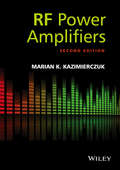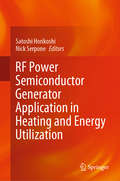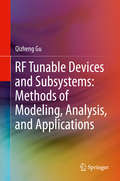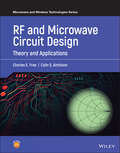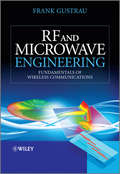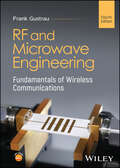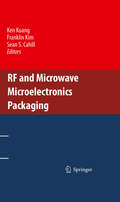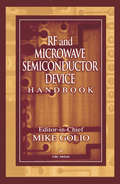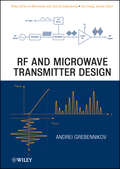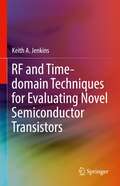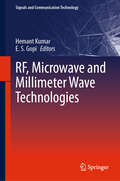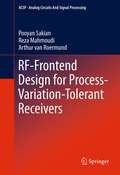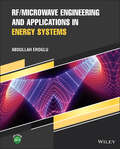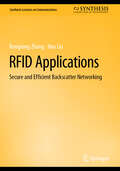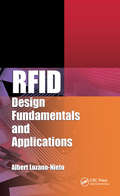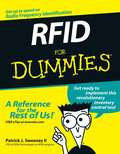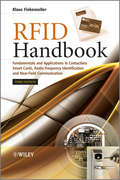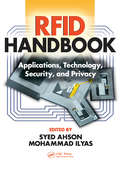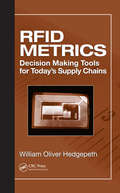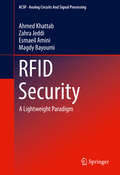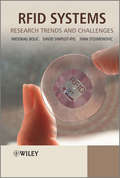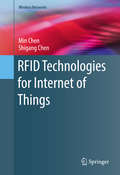- Table View
- List View
RF Power Amplifier
by Marian K. KazimierczukThis second edition of the highly acclaimed RF Power Amplifiers has been thoroughly revised and expanded to reflect the latest challenges associated with power transmitters used in communications systems. With more rigorous treatment of many concepts, the new edition includes a unique combination of class-tested analysis and industry-proven design techniques.Radio frequency (RF) power amplifiers are the fundamental building blocks used in a vast variety of wireless communication circuits, radio and TV broadcasting transmitters, radars, wireless energy transfer, and industrial processes. Through a combination of theory and practice, RF Power Amplifiers, Second Edition provides a solid understanding of the key concepts, the principle of operation, synthesis, analysis, and design of RF power amplifiers.This extensive update boasts: up to date end of chapter summaries; review questions and problems; an expansion on key concepts; new examples related to real-world applications illustrating key concepts and brand new chapters covering 'hot topics' such as RF LC oscillators and dynamic power supplies.Carefully edited for superior readability, this work remains an essential reference for research & development staff and design engineers. Senior level undergraduate and graduate electrical engineering students will also find it an invaluable resource with its practical examples & summaries, review questions and end of chapter problems.Key features: * A fully revised solutions manual is now hosted on a companion website alongside new simulations.* Extended treatment of a broad range of topologies of RF power amplifiers.* In-depth treatment of state-of-the art of modern transmitters and a new chapter on oscillators.* Includes problem-solving methodology, step-by-step derivations and closed-form design equations with illustrations.
RF Power Semiconductor Generator Application in Heating and Energy Utilization
by Nick Serpone Satoshi HorikoshiThis is a specialized book for researchers and technicians of universities and companies who are interested in the fundamentals of RF power semiconductors, their applications and market penetration.Looking around, we see that products using vacuum tube technology are disappearing. For example, branch tube TVs have changed to liquid crystal TVs, and fluorescent light have turned into LED. The switch from vacuum tube technology to semiconductor technology has progressed remarkably. At the same time, high-precision functionalization, miniaturization and energy saving have advanced. On the other hand, there is a magnetron which is a vacuum tube device for generating microwaves. However, even this vacuum tube technology has come to be replaced by RF power semiconductor technology. In the last few years the price of semiconductors has dropped sharply and its application to microwave heating and energy fields will proceed. In some fields the transition from magnetron microwave oscillator to semiconductor microwave oscillator has already begun. From now on this development will progress remarkably. Although there are several technical books on electrical systems that explain RF power semiconductors, there are no books yet based on users' viewpoints on actual microwave heating and energy fields. In particular, none have been written about exact usage and practical cases, to answer questions such as "What are the advantages and disadvantages of RF power semiconductor oscillator?", "What kind of field can be used?" and the difficulty of the market and application. Based on these issues, this book explains the RF power semiconductors from the user's point of view by covering a very wide range of fields.
RF Tunable Devices and Subsystems: Methods of Modeling, Analysis, and Applications
by Qizheng GuThis book serves as a hands-on guide to RF tunable devices, circuits and subsystems. An innovative of modeling for tunable devices and networks is described, along with a new tuning algorithm, adaptive matching network control approach, and novel filter frequency automatic control loop. The author provides readers with the necessary background and methods for designing and developing tunable RF networks/circuits and tunable RF font-ends, with an emphasis on applications to cellular communications.
RF and Microwave Circuit Design: Theory and Applications (Microwave and Wireless Technologies Series)
by Charles E. Free Colin S. AitchisonThis textbook covers a typical modern syllabus in radio frequency or microwave design at final year undergraduate or first year postgraduate level. The content has been chosen to include all of the basic topics necessary to give a rigorous introduction to high-frequency technology. Both the content and presentation reflect the considerable experience which both authors have in teaching and research at university level. The material is presented from first principles, and relies only on students having a reasonable grasp of basic electronic principles. One of the key features of the book is the inclusion of an extensive set of worked examples to guide the student reader who has no prior knowledge of the subject.
RF and Microwave Electromagnetism
by Pierre Jarry Jacques N. BeneatMicrowave and radio frequency (RF) elements play an important role in communication systems, and, due to the proliferation of radar, satellite and mobile wireless systems, there is a need for the study of electromagnetism. Each of the nine chapters of this book provides a complete analysis and modeling of the microwave structure used for emission or reception technology, providing students with a set of approaches that can be used for current and future RF and microwave circuit designs. The authors emphasize the practical nature of the subject by summarizing the analysis steps and giving numerous examples of problems and exercises complete with solutions, making this book theoretical, but also experimental, with over 16 microwave problems. This approach has produced a coherent and practical treatment of the subject. The book has grown out of the authors’ own teaching and, as such, has a unity of methodology and style. It provides basic knowledge of microwave and RF range and is intended for microwave engineers and for advanced graduate students.
RF and Microwave Engineering
by Frank GustrauThis book provides a fundamental and practical introduction to radio frequency and microwave engineering and physical aspects of wireless communicationIn this book, the author addresses a wide range of radio-frequency and microwave topics with emphasis on physical aspects including EM and voltage waves, transmission lines, passive circuits, antennas, radio wave propagation. Up-to-date RF design tools like RF circuit simulation, EM simulation and computerized smith charts, are used in various examples to demonstrate how these methods can be applied effectively in RF engineering practice.Design rules and working examples illustrate the theoretical parts. The examples are close to real world problems, so the reader can directly transfer the methods within the context of their own work. At the end of each chapter a list of problems is given in order to deepen the reader's understanding of the chapter material and practice the new competences. Solutions are available on the author's website.Key Features:Presents a wide range of RF topics with emphasis on physical aspects e.g. EM and voltage waves, transmission lines, passive circuits, antennasUses various examples of modern RF tools that show how the methods can be applied productively in RF engineering practiceIncorporates various design examples using circuit and electromagnetic (EM) simulation softwareDiscusses the propagation of waves: their representation, their effects, and their utilization in passive circuits and antenna structuresProvides a list of problems at the end of each chapterIncludes an accompanying website containing solutions to the problems (http:\\www.fh-dortmund.de\gustrau_rf_textbook)This will be an invaluable textbook for bachelor and masters students on electrical engineering courses (microwave engineering, basic circuit theory and electromagnetic fields, wireless communications). Early-stage RF practitioners, engineers (e.g. application engineer) working in this area will also find this book of interest.
RF and Microwave Engineering: Fundamentals of Wireless Communications
by Frank GustrauA comprehensive guide to the fundamentals of radio frequency (RF), microwave engineering, and the physical aspects of wireless communications. Combining physical-technical fundamentals with numerical simulations, RF and Microwave Engineering presents a wide range of RF topics with emphasis on physical aspects such as electromagnetic (EM) and voltage waves, transmission lines, passive circuits, and antennas. The text discusses the propagation of waves and their representation, effects, and utilization in passive circuits and antenna structures, incorporates various design examples using circuit and EM simulation software, and gives examples of modern RF tools to show how methods can be applied productively in RF engineering practice. This revised edition includes new chapters on monostatic and bistatic radar cross sections (RCS), horn antennas, 5G mobile communications, substrate-integrated-waveguides (SIW), slot antennas, characteristics of resonators, and other topics. A list of practice problems is provided at the end of each chapter and a companion website hosts solutions to the problem sets. Written by a highly qualified professor this is the English language translation of the German original. RF and Microwave Engineering includes: Transmission line theory and transient signals on lines, covering characteristic line impedances, voltage waves, idealized lossless lines and cables with low losses, impedance transformation, reflection coefficient, and Smith chart diagram Waveguides, covering coaxial lines, including weak losses, parallel wire lines, microstrip lines, rectangular waveguides, substrate-integrated-waveguides, and three-wire systemsScattering parameters, covering multiport equations in matrix form, special network properties of circuits, and the signal flow methodHigh-frequency components and circuits, covering line filters, couplers, power dividers, and matching circuitsAntenna concepts and radio wave propagation in complex environments RF and Microwave Engineering is an essential text for undergraduate and graduate students in electrical engineering courses including microwave engineering, basic circuit theory, electromagnetic fields, and wireless communications as well as early-stage RF practitioners and engineers.
RF and Microwave Microelectronics Packaging
by Franklin Kim Ken Kuang Sean S. CahillRF and Microwave Microelectronics Packaging presents the latest developments in packaging for high-frequency electronics. It will appeal to practicing engineers in the electronic packaging and high-frequency electronics fields and to academic researchers interested in understanding leading issues in the commercial sector. It covers the latest developments in thermal management, electrical/RF/thermal-mechanical designs and simulations, packaging and processing methods as well as other RF/MW packaging-related fields.
RF and Microwave Microelectronics Packaging II
by Ken Kuang Rick SturdivantThis book presents the latest developments in packaging for high-frequency electronics. It is a companion volume to "RF and Microwave Microelectronics Packaging" (2010) and covers the latest developments in thermal management, electrical/RF/thermal-mechanical designs and simulations, packaging and processing methods, and other RF and microwave packaging topics. Chapters provide detailed coverage of phased arrays, T/R modules, 3D transitions, high thermal conductivity materials, carbon nanotubes and graphene advanced materials, and chip size packaging for RF MEMS. It appeals to practicing engineers in the electronic packaging and high-frequency electronics domain, and to academic researchers interested in understanding the leading issues in the commercial sector. It is also a good reference and self-studying guide for students seeking future employment in consumer electronics.
RF and Microwave Semiconductor Device Handbook
by Mike GolioOffering a single volume reference for high frequency semiconductor devices, this handbook covers basic material characteristics, system level concerns and constraints, simulation and modeling of devices, and packaging. Individual chapters detail the properties and characteristics of each semiconductor device type, including: Varactors, Schottky diodes, transit-time devices, BJTs, HBTs, MOSFETs, MESFETs, and HEMTs. Written by leading researchers in the field, the RF and Microwave Semiconductor Device Handbook provides an excellent starting point for programs involving development, technology comparison, or acquisition of RF and wireless semiconductor devices.
RF and Microwave Transmitter Design
by Andrei GrebennikovRF and Microwave Transmitter Design is unique in its coverage of both historical transmitter design and cutting edge technologies. This text explores the results of well-known and new theoretical analyses, while informing readers of modern radio transmitters' pracitcal designs and their components. Jam-packed with information, this book broadcasts and streamlines the author's considerable experience in RF and microwave design and development.
RF and Time-domain Techniques for Evaluating Novel Semiconductor Transistors
by Keith A. JenkinsThis book presents a variety of techniques using high-frequency (RF) and time-domain measurements to understand the electrical performance of novel, modern transistors made of materials such as graphene, carbon nanotubes, and silicon-on-insulator, and using new transistor structures. The author explains how to use conventional RF and time- domain measurements to characterize the performance of the transistors. In addition, he explains how novel transistors may be subject to effects such as self-heating, period-dependent output, non-linearity, susceptibility to short-term degradation, DC-invisible structural defects, and a different response to DC and transient inputs. Readers will understand that in order to fully understand and characterize the behavior of a novel transistor, there is an arsenal of dynamic techniques available. In addition to abstract concepts, the reader will learn of practical tips required to achieve meaningful measurements, and will understand the relationship between these measurements and traditional, conventional DC characteristics.
RF, Microwave and Millimeter Wave Technologies (Signals and Communication Technology)
by E. S. Gopi Hemant KumarThis book provides in-depth exposure to emerging technologies and recent advancements in RF, Microwave, and Millimetre Wave Technologies. The book covers the basic concepts along with the recent advancements in designing and developing antennas and circuits for the latest technologies. The concepts of mode compression, Full Duplex communication, massive MIMO, frequency selective surfaces, reflectarrays, and metasurfaces have been discussed in detail. Various types of antennas, such as electrically small antennas, textile antennas, dielectric resonator antennas, etc., to be used for the latest wireless devices, RFID applications are also thoroughly explored. The concept of machine learning to develop data-driven models for antenna design is also discussed briefly to provide readers with an introduction to the ML algorithms. The readers will be able to understand the theoretical concepts and practical design aspects of various antennas, high-frequency circuits, and device modeling. The target audience includes but is not limited to undergraduates, post-graduates, research scholars, academicians, scientists, and professionals who are interested in getting the latest knowledge in the field of RF, Microwave, and Millimetre Wave Technologies.
RF-Frontend Design for Process-Variation-Tolerant Receivers
by Arthur Van Roermund Pooyan Sakian Reza MahmoudiThis book discusses a number of challenges faced by designers of wireless receivers, given complications caused by the shrinking of electronic and mobile devices circuitry into ever-smaller sizes and the resulting complications on the manufacturability, production yield, and the end price of the products. The authors describe the impact of process technology on the performance of the end product and equip RF designers with countermeasures to cope with such problems. The mechanisms by which these problems arise are analyzed in detail and novel solutions are provided, including design guidelines for receivers with robustness to process variations and details of circuit blocks that obtain the required performance level. Describes RF receiver frontends and their building blocks from a system- and circuit-level perspective;Provides system-level analysis of a generic RF receiver frontend with robustness to process variations;Includes details of CMOS circuit design at 60GHz and reconfigurable circuits at 60GHz;Covers millimeter-wave circuit design with robustness to process variations.
RF/Microwave Engineering and Applications in Energy Systems
by Abdullah ErogluRF/MICROWAVE ENGINEERING AND APPLICATIONS IN ENERGY SYSTEMS An essential text with a unique focus on RF and microwave engineering theory and its applications In RF/Microwave Engineering and Applications in Energy Systems, accomplished researcher Abdullah Eroglu delivers a detailed treatment of key theoretical aspects of radio-frequency and microwave engineering concepts along with parallel presentations of their practical applications. The text includes coverage of recent advances in the subject, including energy harvesting methods, RFID antenna designs, HVAC system controls, and smart grids. The distinguished author provides step-by-step solutions to common engineering problems by way of numerous examples and offers end-of-chapter problems and solutions on each topic. These practical applications of theoretical subjects aid the reader with retention and recall and demonstrate a solid connection between theory and practice. The author also applies common simulation tools in several chapters, illustrating the use and implementation of time domain circuit simulators in conjunction with electromagnetic simulators, as well as Matlab for design, simulation, and implementation at the component and system levels. Readers will also benefit from: A thorough introduction to the foundations of electromagnetics, including line, surface, and volume integrals, vector operation and theorems, and Maxwell’s equations Comprehensive explorations of passive and active components in RF and microwave engineering, including resistors, capacitors, inductors, and semiconductor materials and active devices Practical discussions of transmission lines, including transmission line analysis, Smith charts, microstrip lines, and striplines In-depth examinations of network parameters, including impedance parameters, ABCD parameters, h-Hybrid parameters, and network connections Perfect for senior-level undergraduates and graduate students studying RF or Microwave engineering, RF/Microwave Engineering and Applications in Energy Systems is also an indispensable resource for professionals whose work touches on radio-frequency and microwave technologies.
RFID Applications: Secure and Efficient Backscatter Networking (Synthesis Lectures on Communications)
by Hao Liu Rongrong ZhangThis book introduces current efficient and secure backscatter networking schemes for RFID. The authors integrate these schemes with a concrete example, namely RFID-based missing item detection. The book presents a large palette of tools indispensable in the RFID-based passive IoT (such as compute complexity analysis, approximate algorithm design, the probabilistic data structure, and the protocol stack in COTS and software-defined RFID tags) and how these tools can be carefully tuned and adapted to be practically applied in RFID systems. The book elaborates the state-of-the-art research bringing the conventional data structure and traffic engineering technology in the core network into the emerging IoT applications of RFID. This does not only boost the performance for RFID systems, but also inspires new research directions. The authors believe that this book will interest researchers, professionals, and graduates working in RFID system design and engineering, low-power IoT as well as other related fields.
RFID Design Fundamentals and Applications
by Albert Lozano-NietoRFID is an increasingly pervasive tool that is now used in a wide range of fields. It is employed to substantiate adherence to food preservation and safety standards, combat the circulation of counterfeit pharmaceuticals, and verify authenticity and history of critical parts used in aircraft and other machinery—and these are just a few of its uses. Goes beyond deployment, focusing on exactly how RFID actually works RFID Design Fundamentals and Applications systematically explores the fundamental principles involved in the design and characterization of RFID technologies. The RFID market is exploding. With new and enhanced applications becoming increasingly integral to government and industrial chain supply and logistics around the globe, professionals must be proficient in the evaluation and deployment of these systems. Although manufacturers provide complete and extensive documentation of each individual RFID component, it can be difficult to synthesize and apply this complex information—and users often must consult and integrate data from several producers for different components. This book covers topics including: Types of antennas used in transponders Components of the transponder, memory structure and logic circuits Antennae for RFID interrogators Types of modulation Organization and characteristics of commercial transponders Communication links Modes of operation for transponders operating at different frequencies Principles of arbitration and anti-collision Commands used by transponders This powerful reference helps to resolve this dilemma by compiling a systematic overview of the different parts that make up the whole RFID system, helping the reader develop a clear and understanding of its mechanisms and how the technology actually works. Most books on RFID focus on commercial use and deployment of the technology, but this volume takes a different and extremely useful approach. Directed toward both professionals and students in electronics, telecommunications, and new technologies, it fills the informational void left by other books, illustrating specific examples of available semiconductors and integrated circuits to clearly explain how RFID systems are configured, how they work, and how different system components interact with each other.
RFID For Dummies
by Ii Patrick J. SweeneyMany companies have asked suppliers to begin using RFID (radio frequency identification) tags by 2006 RFID allows pallets and products to be scanned at a greater distance and with less effort than barcode scanning, offering superior supply-chain management efficiencies This unique plain-English resource explains RFID and shows CIOs, warehouse managers, and supply-chain managers how to implement RFID tagging in products and deploy RFID scanning at a warehouse or distribution center Covers the business case for RFID, pilot programs, timelines and strategies for site assessments and deployments, testing guidelines, privacy and regulatory issues, and more
RFID Handbook
by Klaus Finkenzeller Dörte MüllerThis is the third revised edition of the established and trusted RFID Handbook; the most comprehensive introduction to radio frequency identification (RFID) available.This essential new edition contains information on electronic product code (EPC) and the EPC global network, and explains near-field communication (NFC) in depth. It includes revisions on chapters devoted to the physical principles of RFID systems and microprocessors, and supplies up-to-date details on relevant standards and regulations.Taking into account critical modern concerns, this handbook provides the latest information on:the use of RFID in ticketing and electronic passports; the security of RFID systems, explaining attacks on RFID systems and other security matters, such as transponder emulation and cloning, defence using cryptographic methods, and electronic article surveillance; frequency ranges and radio licensing regulations. The text explores schematic circuits of simple transponders and readers, and includes new material on active and passive transponders, ISO/IEC 18000 family, ISO/IEC 15691 and 15692. It also describes the technical limits of RFID systems.A unique resource offering a complete overview of the large and varied world of RFID, Klaus Finkenzeller's volume is useful for end-users of the technology as well as practitioners in auto ID and IT designers of RFID products. Computer and electronics engineers in security system development, microchip designers, and materials handling specialists benefit from this book, as do automation, industrial and transport engineers. Clear and thorough explanations also make this an excellent introduction to the topic for graduate level students in electronics and industrial engineering design.Klaus Finkenzeller was awarded the Fraunhofer-Smart Card Prize 2008 for the second edition of this publication, which was celebrated for being an outstanding contribution to the smart card field.
RFID Handbook: Applications, Technology, Security, and Privacy
by Mohammad Ilyas Syed A. AhsonRadio Frequency Identification (RFID) tagging is now used by the department of defense and many of the world’s largest retailers including Wal-Mart. As RFID continues to infiltrate industries worldwide, organizations must harness a clear understanding of this technology in order to maximize its potential and protect against the potential risks it poses. The RFID Handbook provides an overview of RFID technology, its associated security and privacy risks, and recommended practices that will enable organizations to realize productivity improvements while also protecting sensitive information and the privacy of individuals. Expert contributors present a host of applications including RFID enabled automated receiving, triage with RFID for massive incidents, RFID and NFC in relation to mobile phones, and RFID technologies for communication robots and a privacy preserving video surveillance system. The unprecedented coverage also includes detailed descriptions of adaptive splitting protocols as well as tree-based and probabilistic anti-collision protocols. Drawing on its distinguished editors and world-renowned contributors, this one-of-a-kind handbook serves as the ultimate reference on RFID, from basic research concepts to future applications.
RFID Metrics: Decision Making Tools for Today's Supply Chains
by William Oliver HedgepethIn today's hyper-competitive business climate, organizations are always under pressure to adapt to new technological trends or "hot" business process models. Based on the author's experience testing and implementing RFID technology in both industrial and military cases, this text explains how to evaluate the need for this technology. The author focuses on what problems RFID is meant to solve, if such problems exist in an organization, and what metrics to use for effective decision making. After establishing what RFID is and how it fits into the systems concept, the book discusses current RFID applications around the world, reveals key metrics for decision making as well as how to develop new metrics unique to RFID, demonstrates a war game for exploring RFID, and presents statistical methods for analyzing the data collected from the war games or gathered during implementation.
RFID Security
by Magdy Bayoumi Ahmed Khattab Zahra Jeddi Esmaeil AminiThis book provides a comprehensive treatment of security in the widely adopted, Radio Frequency Identification (RFID) technology. The authors present the fundamental principles of RFID cryptography in a manner accessible to a broad range of readers, enabling them to improve their RFID security design. This book also offers the reader a range of interesting topics portraying the current state-of-the-art in RFID technology and how it can be integrated with today's Internet of Things (IoT) vision. The authors describe a first-of-its-kind, lightweight symmetric authenticated encryption cipher called Redundant Bit Security (RBS), which enables significant, multi-faceted performance improvements compared to existing cryptosystems. This book is a must-read for anyone aiming to overcome the constraints of practical implementation in RFID security technologies.
RFID Security
by Anita Campbell Anand Das Brad Haines John Kleinschmidt Frank ThorntonRFID (Radio Frequency Identification) is a method of remotely storing and receiving data using devices called RFID tags. RFID tags can be small adhesive stickers containing antennas that allow them to receive and respond to transmissions from RFID transmitters. RFID tags are used to identify and track everything from Exxon EZ passes to dogs to beer kegs to library books. RFID tags use a standard that has already been hacked by several researchers. There are several motives for someone wanting to hack an RFID system: For monetary gain. Hacking a store's RFID system would allow a hacker to lower the pricing on any product(s). One could also steal cars (Prius or Lexus already have RFID keys) with RFID-encoded keys. Wreak havoc with someone's supply chain. Malicous/mischievous hackers can delete/alter/modify all identifying information for an entire shipment of products. Protect personal privacy. Privacy advocates fear that RFID tags embedded in products (which continue to transmit information after leaving a store) will be used to track consumer habits. RFID tags are also being tested as a means for identifying individuals on passports, driver's licenses, etc. This also has the ACLU types up in arms because, just like RFID tags in consumer products, these tags would be "always on" and broadcasting your personal information wherever you are.
RFID Systems
by Ivan Stojmenovic Miodrag Bolic David Simplot-RylThis book provides an insight into the 'hot' field of Radio Frequency Identification (RFID) SystemsIn this book, the authors provide an insight into the field of RFID systems with an emphasis on networking aspects and research challenges related to passive Ultra High Frequency (UHF) RFID systems. The book reviews various algorithms, protocols and design solutions that have been developed within the area, including most recent advances. In addition, authors cover a wide range of recognized problems in RFID industry, striking a balance between theoretical and practical coverage. Limitations of the technology and state-of-the-art solutions are identified and new research opportunities are addressed. Finally, the book is authored by experts and respected researchers in the field and every chapter is peer reviewed.Key Features:Provides the most comprehensive analysis of networking aspects of RFID systems, including tag identification protocols and reader anti-collision algorithms Covers in detail major research problems of passive UHF systems such as improving reading accuracy, reading range and throughput Analyzes other "hot topics" including localization of passive RFID tags, energy harvesting, simulator and emulator design, security and privacy Discusses design of tag antennas, tag and reader circuits for passive UHF RFID systems Presents EPCGlobal architecture framework, middleware and protocols Includes an accompanying website with PowerPoint slides and solutions to the problems http://www.site.uottawa.ca/~mbolic/RFIDBook/This book will be an invaluable guide for researchers and graduate students in electrical engineering and computer science, and researchers and developers in telecommunication industry.
RFID Technologies for Internet of Things
by Shigang Chen Min ChenThis book introduces applications of RFID on the Internet of things, under the emerging technologies for tag search, anonymous RFID authentication, and identification of networked tags. A new technique called filtering vector (a compact data structure that encodes tag IDs) is proposed to enable tag filtration, meeting the stringent delay requirements for real-world applications. Based on filtering vectors, a novel iterative tag search protocol is designed, which progressively improves the accuracy of search result and reduces the time of each iteration by using the information learned from the previous iterations. Moreover, the protocol is extended to work under noisy channel. The authors also make a fundamental shift from the traditional design paradigm for anonymous RFID authentication by following an asymmetry design principle that pushes most complexity to the readers while leaving the tags as simple as possible. A novel technique is developed to dynamically generate random tokens on demand for authentication. The token-based authentication protocol only requires O(1) communication overhead and online computation overhead per authentication for both readers and tags. Finally, the authors investigate the problem of networked-tag identification. The traditional contention-based protocol design will incur too much energy overhead in multihop tag systems, and a reader-coordinated design that significantly serializes tag transmissions performs much better. In addition, a solution based on serial numbers is proposed to achieve load balancing, thereby reducing the worst-case energy cost among the tags. Designed for researchers and professionals, this SpringerBrief will interest individuals who work in efficiency, security, and privacy. Advanced-level students focused on network design will also benefit from the content.
